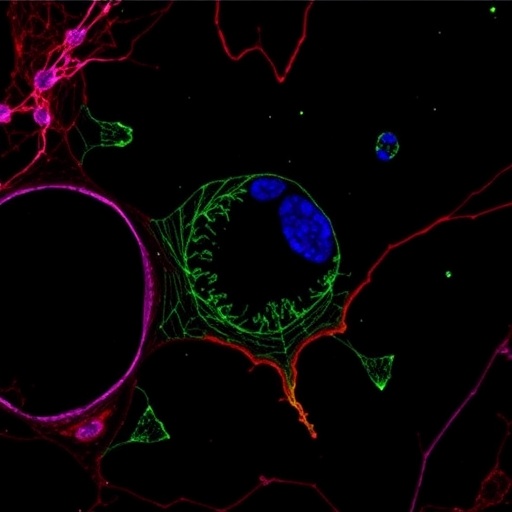
In recent years, the scientific community has increasingly turned its attention toward the molecular underpinnings of cancer progression, aiming to unravel the complex signaling pathways that fuel tumor growth and metastasis. One protein gaining remarkable interest for its multifaceted role in oncogenesis is Proline-, Glutamic acid-, and Leucine-rich Protein 1 (PELP1). The latest research, spearheaded by Xie and colleagues, adds a significant piece to this intricate puzzle by elucidating how PELP1 influences proliferation, metastasis, and angiogenesis specifically in epithelial ovarian cancer, a notoriously aggressive malignancy with poor clinical outcomes. These findings, recently published in Medical Oncology, offer not only an enhanced understanding of PELP1’s functional dynamics but also open potential avenues for targeted therapies that could transform treatment paradigms for ovarian cancer patients.
Epithelial ovarian cancer remains one of the deadliest gynecologic cancers worldwide, largely due to its late diagnosis and profound capacity for metastasis. Despite advances in surgery and chemotherapy, recurrence and resistance continue to plague therapeutic success. Against this backdrop, identifying molecular drivers of malignancy is critical. PELP1 has been implicated in various cancers as a nuclear receptor co-regulator impacting estrogen receptor signaling, but its definitive role in ovarian cancer biology had remained elusive. Xie et al. undertook a comprehensive investigation into how PELP1 modulates not only tumor cell proliferation but also the broader tumor microenvironment, including angiogenesis – the formation of new blood vessels feeding tumor growth – and metastatic competency.
The research leverages an array of experimental techniques, employing both in vitro cellular models and in vivo animal studies to delineate PELP1’s impact. Initial analyses demonstrated that elevated expression of PELP1 correlated with enhanced proliferation rates in multiple ovarian cancer cell lines. Mechanistically, this effect is underscored by PELP1’s ability to interface with receptors and transcriptional machinery that regulate cell cycle progression and survival signals. The data suggest that PELP1 acts as a critical hub linking hormonal signaling with oncogenic pathways, boosting cellular proliferation beyond normal regulatory limits.
.adsslot_yk5LSABNud{width:728px !important;height:90px !important;}
@media(max-width:1199px){ .adsslot_yk5LSABNud{width:468px !important;height:60px !important;}
}
@media(max-width:767px){ .adsslot_yk5LSABNud{width:320px !important;height:50px !important;}
}
ADVERTISEMENT
Beyond proliferation, metastasis represents the most formidable challenge in combating ovarian cancer. Through intricate signaling network analyses, the study revealed that PELP1 significantly upregulates factors associated with epithelial-to-mesenchymal transition (EMT), a process by which cancer cells acquire migratory and invasive traits. Elevated PELP1 levels fostered a microenvironment conducive to cellular detachment and dissemination – hallmarks of metastatic progression. This delineation of PELP1 as a metastasis-promoting factor is particularly compelling, providing mechanistic clarity on how ovarian cancer cells commandeer native signaling to facilitate spread throughout the peritoneal cavity and beyond.
Moreover, the study delves into PELP1’s role in tumor-induced angiogenesis. Angiogenesis is a critical process by which tumors ensure an adequate supply of oxygen and nutrients through new vascular networks. Xie et al. uncovered that PELP1 enhances the expression of angiogenic factors such as vascular endothelial growth factor (VEGF), effectively endowing tumors with greater vascularization potential. This amplifies tumor survival and growth, while concurrently creating avenues for metastatic cells to enter circulation. The interplay between PELP1 and angiogenic signaling cascades emphasizes the protein’s versatility in manipulating the tumor microenvironment to favor malignancy.
Intriguingly, the research highlights that PELP1’s oncogenic effects are not solely cell-autonomous but also involve paracrine interactions. Tumor cells with high PELP1 expression secrete factors that modulate surrounding stromal and endothelial cells, thereby orchestrating a tumor niche that supports aggressive cancer phenotypes. Such findings underscore the importance of targeting the tumor microenvironment as a complementary strategy in ovarian cancer therapy.
Delving deeper into the molecular mechanisms, it was observed that PELP1 interacts with various coregulators and transcription factors to reprogram gene expression profiles critical for cancer progression. These interactions extend to pivotal signaling nodes such as the PI3K/AKT and MAPK pathways, both known drivers of oncogenic behavior. The robust crosstalk fostered by PELP1 underscores its potential as a master regulator within the oncogenic network, capable of amplifying malignant phenotypes through multiple molecular axes.
Therapeutically, targeting PELP1 represents an innovative and promising strategy. The study explored knockdown experiments via siRNA techniques, demonstrating marked attenuation of tumor cell proliferation, invasiveness, and angiogenic potential upon PELP1 silencing. These preclinical observations hint at the viability of developing small-molecule inhibitors or biologics that selectively neutralize PELP1 function, thereby impeding the multifaceted oncogenic processes it orchestrates.
Of particular note is the potential use of PELP1 status as a prognostic biomarker. Patients with higher PELP1 expression exhibited poorer survival rates, reinforcing its relevance not only as a mechanistic player but also as a clinical indicator of disease aggressiveness. Incorporating PELP1 assessment into diagnostic frameworks could enhance risk stratification and guide personalized treatment decisions.
This study also highlights the need for further exploration into PELP1’s interactions with hormone receptors beyond estrogen, including potential cross-talk with androgen and progesterone receptors, which might contribute to the heterogeneity observed in ovarian cancer responses. Such research could unravel complex signaling hierarchies influencing tumor behavior and resistance.
While these findings represent a significant advancement, the authors caution that translating PELP1-targeted approaches into clinical therapies will require meticulous design to overcome challenges related to drug specificity and delivery. Additionally, understanding compensatory mechanisms that tumors might deploy in response to PELP1 inhibition is essential to preclude therapeutic resistance.
In conclusion, Xie and colleagues’ work not only elucidates the pivotal role of PELP1 in the aggressive biology of epithelial ovarian cancer but also propels the field toward novel molecular interventions. The intricate involvement of PELP1 in proliferation, metastasis, and angiogenesis reveals an oncogenic lynchpin that integrates hormonal signaling with tumor microenvironment modulation. This comprehensive portrait of PELP1’s functionality paves the way for innovative treatments aimed at disrupting the core drivers of ovarian cancer lethality.
As ovarian cancer remains a formidable adversary in oncology, efforts such as these underscore the importance of dissecting molecular intricacies that fuel malignancy. By illuminating the pathways through which PELP1 exerts its influence, the study offers hope for breakthroughs that could dramatically alter patient outcomes. The continued pursuit of PELP1-targeted therapies, coupled with refined biomarker-driven clinical strategies, may ultimately transform the landscape of ovarian cancer management.
Subject of Research: The role and mechanisms of PELP1 in the proliferation, metastasis, and angiogenesis of epithelial ovarian cancer.
Article Title: Effects of PELP1 on proliferation, metastasis and angiogenesis of epithelial ovarian cancer.
Article References:
Xie, L., Sun, C., Mao, Y. et al. Effects of PELP1 on proliferation, metastasis and angiogenesis of epithelial ovarian cancer. Med Oncol 42, 379 (2025). https://doi.org/10.1007/s12032-025-02908-w
Image Credits: AI Generated
Tags: angiogenesis in cancercancer biology research advancementsepithelial ovarian cancer researchestrogen receptor signaling in malignancylate diagnosis of gynecologic cancersmolecular mechanisms of cancer progressiononcogenic signaling pathwaysovercoming chemotherapy resistancePELP1 protein in ovarian cancertargeted therapies for ovarian cancertumor growth and metastasisXie et al. ovarian cancer study






